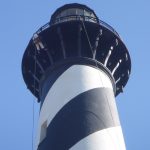In 1794, Congress authorized the first lighthouse on Cape Hatteras to protect ships from one of the most dangerous shoals on the Atlantic coast. The current Cape Hatteras Lighthouse was built between 1868 and 1870, replacing the original lighthouse damaged during the Civil War. The lighthouse is approximately 200 feet tall, comprised of inner and outer brick walls connected by a series of twelve radial interstitial walls. The exterior displays a spiraling alternating black and white painted daymark, first applied in 1873. A cast iron spiral stair allows access to the lantern level at the interior, with landings supported by cast iron beams let into the brick inner wall. In 1999, in order to protect the light station from shoreline erosion, the lighthouse, keeper’s quarters, and other ancillary structures were moved a total of 2,900 feet to a location 1,500 feet from the ocean. The National Park Service owns the lighthouse as part of the Cape Hatteras National Seashore.
Challenges
- Document existing conditions at the interior and exterior of the lighthouse in order to assist the NPS with the preparation of construction documents for repairs with minimal impact to visitors.
- Develop recommendations for crack monitoring at the interior and exterior masonry.
Solutions
- Used industrial rope access to perform a hands-on and close-visual inspection of the lighthouse exterior.
- Documented representative and notable conditions at the exterior and interior masonry using the Tablet PC Annotation System® (TPAS).
- Used an FLIR E60 infrared camera to evaluate the extent and pattern of moisture within the wall materials.
- Installed crack gauges at 10 locations on the plinth and interior, and trained NPS personnel in how to take readings.
In collaboration with
- National Park Service Historic Preservation Training Center
- Cape Hatteras National Seashore


